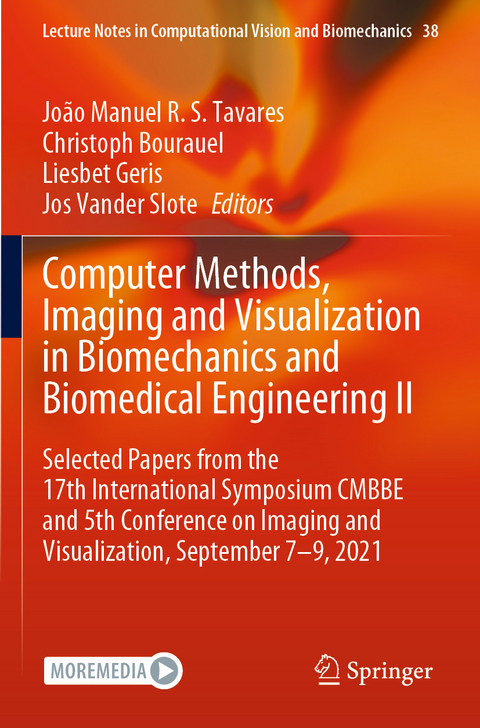
Computer Methods, Imaging and Visualization in Biomechanics and Biomedical Engineering II
Springer International Publishing (Verlag)
978-3-031-10017-8 (ISBN)
This book gathers selected, extended and revised contributions to the 17th International Symposium on Computer Methods in Biomechanics and Biomedical Engineering and the 5th Conference on Imaging and Visualization (CMBBE 2021), held online on September 7-9, 2021, from Bonn, Germany. It reports on cutting-edge models, algorithms and imaging techniques for studying cells, tissues and organs in normal and pathological conditions. It covers numerical and machine learning methods, finite element modeling and virtual reality techniques, applied to understand biomechanics of movement, fluid and soft tissue biomechanics. It also reports on related advances in rehabilitation, surgery and diagnosis. All in all, this book offers a timely snapshot of the latest research and current challenges at the interface between biomedical engineering, computational biomechanics and biological imaging. Thus, it is expected to provide a source of inspiration for future research and cross-disciplinary collaborations.
lt;p>
A Spatial Markov Chain Cellular Automata Model for the Spread of Viruses.- A Novel Review of Temporomandibular Joint Replacement Options.- Could an Exoskeleton-driven Rehabilitation Treatment Improve Muscle Forces Generation in PD? A Pilot Study.- EMG Signals as a Way to Control Soft Actuators.- Movement Optimization through Musculoskeletal Modeling and Multidimensional Surface Interpolation.- Simulating the Dynamics of a Human-Exoskeleton System Using Kinematic Data with Misalignment between the Human and Exoskeleton Joints.- Modeling of Nonlinear Ultrasound Propagation in Trans-cranial MRgFUS Technique: A 2D-FEM Analysis.- Predicting Neurological Effects Associated with Traumatic Brain Injuries Using Video Analysis and Finite Element Modeling.- Dense-discrete Phase Simulations of Blood Flow in a Stenotic Coronary.- Predicting the Efficacy of Stalk Cells Following Leading Cells through a Micro-Channel Using Morphoelasticity and a Cell Shape Evolution Model.- Simulation of Cell Proliferation using a Meshless Tool.- Explicit Non-linear Finite Element Analysis for Prediction of Primary Stability in Uncemented Total Hip Arthroplasty.- Hemodynamic Effects of Entry Versus Exit Tear Size and Tissue Stiffness in Simulations of Aortic Dissection.- Reproducibility of in Vivo Constitutive Parameter Identi-Fication Based on 4D Ultrasound Strain Imaging.- A Systematic Review of the Uses and Benefits of 3-D printing in Orthopaedic Surgery.
| Erscheinungsdatum | 01.08.2023 |
|---|---|
| Reihe/Serie | Lecture Notes in Computational Vision and Biomechanics |
| Zusatzinfo | XIII, 292 p. 136 illus., 111 illus. in color. |
| Verlagsort | Cham |
| Sprache | englisch |
| Maße | 155 x 235 mm |
| Gewicht | 474 g |
| Themenwelt | Medizin / Pharmazie ► Physiotherapie / Ergotherapie ► Orthopädie |
| Technik | |
| Schlagworte | 3D Printing in Orthopaedic Surgery • Artificial Muscle Control • Biomechanical Models • bone-implant interface • Bone Strain Measurements • Brain Biomechanics and Imaging • CMBBE2021 • Computational Hemodynamics • Computational Models of Soft Tissues • Epithelial Tissue Modeling • FEM modeling • Kinematic Modeling • Medical Ultrasound Imaging • Muskoloskeletal Modeling • Patient-Specific Implants • Reconstruction of Vascular Networks • Simulation of Blood Flow • Speech Recognition Model • Wearable Exoskeletons for Rehabilitation |
| ISBN-10 | 3-031-10017-4 / 3031100174 |
| ISBN-13 | 978-3-031-10017-8 / 9783031100178 |
| Zustand | Neuware |
| Haben Sie eine Frage zum Produkt? |
aus dem Bereich


